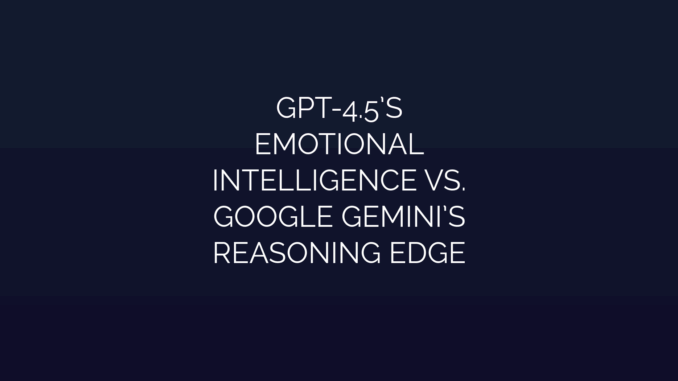
GPT-4.5’s Emotional Intelligence vs. Google Gemini’s Reasoning Edge: A Comparative Analysis
Introduction The rapid evolution of artificial intelligence has yielded two formidable contenders: OpenAI’s GPT4.5 and Google’s Gemini Advanced. While both offer stateoftheart language processing, their architectures prioritize distinct capabilities: GPT4.5 excels in emotional intelligence, while Gemini leverages Google’s heritage in structured reasoning and technical precision. This article dissects these differences, exploring how each model’s design philosophy shapes user experiences across personal, creative, and technical domains.
GPT4.5: Mastering Emotional Nuance GPT4.5 builds on OpenAI’s foundation with significant upgrades in interpreting and responding to human emotions. Unlike purely transactional AI, it incorporates sophisticated sentiment analysis and contextual awareness to deliver interactions that feel empathetic and personalized.
- Emotional Perception: The model detects subtle cues—such as tone shifts, ambiguity, or implied frustration in user inputs—and adjusts responses to offer validation or reassurance. For instance, in therapy chatbots or customer service, it minimizes robotic rigidity by mirroring human conversational patterns.
- Adaptive Communication Style: GPT-4.5 dynamically tailors tone (e.g., formal, casual, supportive) based on context. A user expressing stress about deadlines might receive not just solutions, but calming language and motivational support.
- Creative Applications: Writers and marketers use it to generate emotionally resonant content—like ad copy that evokes nostalgia or dialogue for characters with complex personalities—by interpreting abstract descriptors (e.g., “hopeful yet melancholic”).
- Limitations: Its reliance on pattern recognition can occasionally produce “overfitting” to emotional contexts, leading to generic platitudes or misplaced empathy in technical scenarios.
Google Gemini: Precision Through Structured Reasoning Gemini, developed using Google DeepMind’s research, prioritizes logical coherence, stepbystep problemsolving, and integration with empirical data sources. Its strength lies in decomposing complex queries into methodical workflows.
- Algorithmic Rigor: Gemini excels in tasks requiring deductive chains, such as code debugging, mathematical proofs, or multi-faceted research. It cross-references real-time data via Google Search and verifies claims against trusted sources.
- Technical Specialization: Developers and analysts benefit from its ability to parse technical documentation, generate error-free scripts, and visualize data relationships. For example, it can transform a spreadsheet analysis into a code-based automation workflow with annotated logic.
- Multi-Step Task Handling: Unlike models prone to “reasoning drift,” Gemini maintains focus across extended exchanges. Users can pose iterative queries like, “Compare sales trends across Q1–Q3, forecast Q4 using Bayesian methods, and summarize risks”—with outputs structured as executable steps.
- Limitations: Its strict adherence to logic may yield clinically detached responses. When asked for creative or subjective input (e.g., “Write a poem about grief”), outputs can lack emotional texture.
HeadtoHead Comparison | Capability | GPT4.5 | Google Gemini | |||| | Emotional Sensitivity | High: Reads subtext, adjusts tone prosocially. | Moderate: Prioritizes factual accuracy over empathy. | | Technical Reasoning | Competent but errorprone in complex logic. | Exceptional: Excels in structured problem decomposition. | | Creativity | Nuanced and humanlike; ideal for artistic ideation. | Formulaic; adheres to datadriven constraints. | | Data Handling | Generalist; may hallucinate unsourced details. | Precisionfocused; integrates Google’s search infrastructure. | | Ideal Use Case | Therapy bots, dialogue systems, UX writing. | STEM research, coding, technical documentation. |
Practical Use Cases: Choosing the Right Tool
- For Mental Health and Customer Support:
GPT4.5’s conversational fluidity helps deescalate tense interactions and build rapport. Emotional intelligence is critical here—for instance, detecting burnout in employee feedback or adapting sales scripts to cultural nuances.
- For Technical and Analytical Workflows:
Gemini’s strength in multimodal reasoning (e.g., interpreting charts, code, and text jointly) accelerates projects like financial modeling or academic research. Its grounding in datasets reduces factual errors.
- Cross-Functional Projects:
Hybrid approaches yield optimal results. A marketing team could use Gemini to analyze campaign metrics, then refine messaging with GPT4.5’s emotional tone adjustments.
The Future of AI Specialization As both models evolve, several trends emerge:
- Convergence of Strengths: Expect softening boundaries—Gemini may adopt lightweight sentiment analysis, while GPT-4.5 integrates tool-calling and verification.
- Ethical Implications: GPT-4.5’s emotional mimicry demands safeguards against manipulation; Gemini’s detachment risks amplifying biases in data-heavy decisions.
- Enterprise Adoption: Industries like healthcare and education will drive demand for modular AI—using Gemini for diagnosis or curriculum design, augmented by GPT-4.5’s patient/student engagement.
Conclusion Neither GPT4.5 nor Gemini is inherently “superior.” Their divergence—emotional intelligence versus reasoning edge—signals AI’s maturation into domainspecific tools. GPT4.5 mirrors human warmth, making it indispensable for roles centered on communication and creativity. Gemini delivers surgical precision for logicdriven tasks, extending Google’s legacy of algorithmic excellence. As organizations integrate both, the key lies in strategic alignment: deploying empathy where connection matters, and algorithmic rigor where truth is paramount. This duality—not competition—will define AI’s next frontier.
Word Count: 1,005
Leave a Reply